MERCEDES-BENZ SL-Class 2015 R131 Owner's Manual
Manufacturer: MERCEDES-BENZ, Model Year: 2015, Model line: SL-Class, Model: MERCEDES-BENZ SL-Class 2015 R131Pages: 610, PDF Size: 12.21 MB
Page 591 of 610
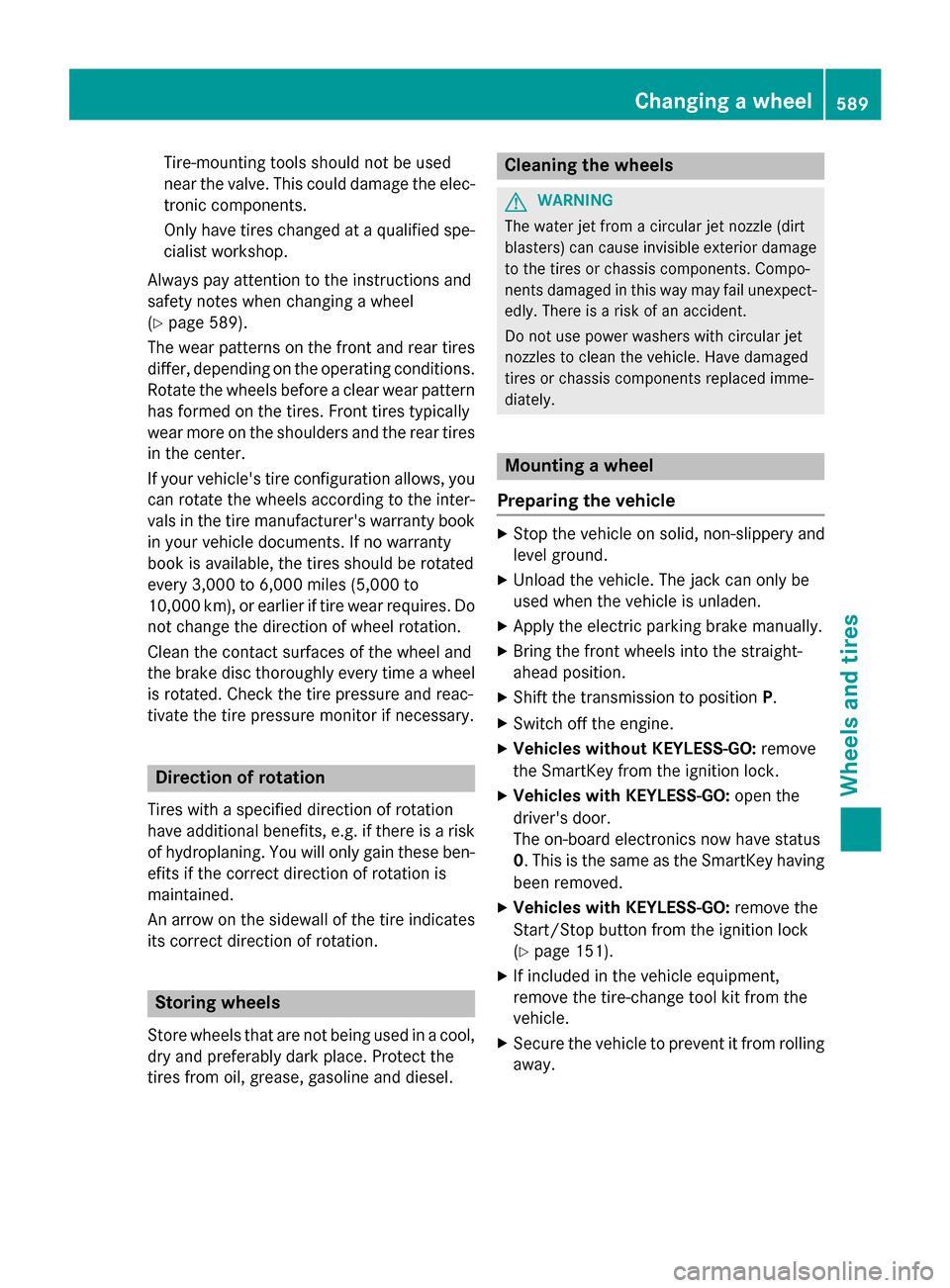
Tire-mounting tools should not be used
near the valve. This could damage the elec-
tronic components.
Only have tires changed at a qualified spe- cialist workshop.
Always pay attention to the instructions and
safety notes when changing a wheel
(Y page 589).
The wear patterns on the front and rear tires
differ, depending on the operating conditions.
Rotate the wheels before a clear wear pattern has formed on the tires. Front tires typically
wear more on the shoulders and the rear tires in the center.
If your vehicle's tire configuration allows, you
can rotate the wheels according to the inter-
vals in the tire manufacturer's warranty book in your vehicle documents. If no warranty
book is available, the tires should be rotated
every 3,000 to 6,000 miles (5,000 to
10,000 km), or earlier if tire wear requires. Do
not change the direction of wheel rotation.
Clean the contact surfaces of the wheel and
the brake disc thoroughly every time a wheel
is rotated. Check the tire pressure and reac-
tivate the tire pressure monitor if necessary. Direction of rotation
Tires with a specified direction of rotation
have additional benefits, e.g. if there is a risk
of hydroplaning. You will only gain these ben-
efits if the correct direction of rotation is
maintained.
An arrow on the sidewall of the tire indicates its correct direction of rotation. Storing wheels
Store wheels that are not being used in a cool, dry and preferably dark place. Protect the
tires from oil, grease, gasoline and diesel. Cleaning the wheels
G
WARNING
The water jet from a circular jet nozzle (dirt
blasters) can cause invisible exterior damage to the tires or chassis components. Compo-
nents damaged in this way may fail unexpect-edly. There is a risk of an accident.
Do not use power washers with circular jet
nozzles to clean the vehicle. Have damaged
tires or chassis components replaced imme-
diately. Mounting a wheel
Preparing the vehicle X
Stop the vehicle on solid, non-slippery and
level ground.
X Unload the vehicle. The jack can only be
used when the vehicle is unladen.
X Apply the electric parking brake manually.
X Bring the front wheels into the straight-
ahead position.
X Shift the transmission to position P.
X Switch off the engine.
X Vehicles without KEYLESS-GO: remove
the SmartKey from the ignition lock.
X Vehicles with KEYLESS-GO: open the
driver's door.
The on-board electronics now have status
0. This is the same as the SmartKey having
been removed.
X Vehicles with KEYLESS-GO: remove the
Start/Stop button from the ignition lock
(Y page 151).
X If included in the vehicle equipment,
remove the tire-change tool kit from the
vehicle.
X Secure the vehicle to prevent it from rolling
away. Changing a wheel
589Wheels and tires Z
Page 592 of 610
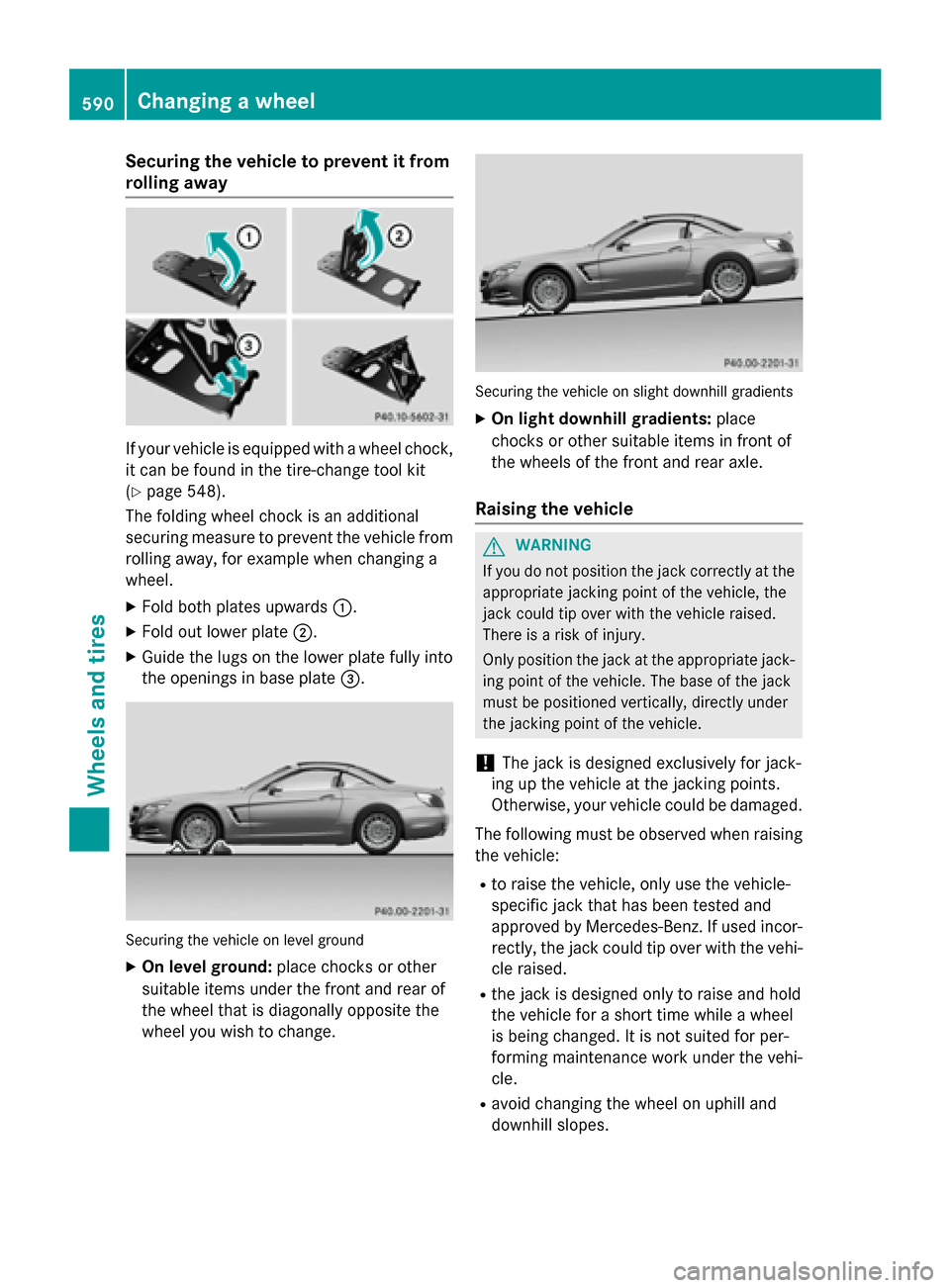
Securing the vehicle to prevent it from
rolling away If your vehicle is equipped with a wheel chock,
it can be found in the tire-change tool kit
(Y page 548).
The folding wheel chock is an additional
securing measure to prevent the vehicle from
rolling away, for example when changing a
wheel.
X Fold both plates upwards 0043.
X Fold out lower plate 0044.
X Guide the lugs on the lower plate fully into
the openings in base plate 0087.Securing the vehicle on level ground
X On level ground: place chocks or other
suitable items under the front and rear of
the wheel that is diagonally opposite the
wheel you wish to change. Securing the vehicle on slight downhill gradients
X On light downhill gradients: place
chocks or other suitable items in front of
the wheels of the front and rear axle.
Raising the vehicle G
WARNING
If you do not position the jack correctly at the appropriate jacking point of the vehicle, the
jack could tip over with the vehicle raised.
There is a risk of injury.
Only position the jack at the appropriate jack-
ing point of the vehicle. The base of the jack
must be positioned vertically, directly under
the jacking point of the vehicle.
! The jack is designed exclusively for jack-
ing up the vehicle at the jacking points.
Otherwise, your vehicle could be damaged.
The following must be observed when raising
the vehicle:
R to raise the vehicle, only use the vehicle-
specific jack that has been tested and
approved by Mercedes-Benz. If used incor-
rectly, the jack could tip over with the vehi-
cle raised.
R the jack is designed only to raise and hold
the vehicle for a short time while a wheel
is being changed. It is not suited for per-
forming maintenance work under the vehi- cle.
R avoid changing the wheel on uphill and
downhill slopes. 590
Changing a wheelWheels and tires
Page 593 of 610

R
before raising the vehicle, secure it from
rolling away by applying the parking brake
and inserting wheel chocks. Never disen-
gage the parking brake while the vehicle is raised.
R the jack must be placed on a firm, flat and
non-slip surface. On a loose surface, a
large, flat, load-bearing underlay must be
used. On a slippery surface, a non-slip
underlay must be used, e.g. rubber mats.
R do not use wooden blocks or similar
objects as a jack underlay. Otherwise, the
jack will not be able to achieve its load-
bearing capacity due to the restricted
height.
R make sure that the distance between the
underside of the tires and the ground does
not exceed 1.2 in (3 cm).
R never place your hands and feet under the
raised vehicle.
R do not lie under the vehicle.
R do not start the engine when the vehicle is
raised.
R do not open or close a door or the trunk lid
when the vehicle is raised.
R make sure that no persons are present in
the vehicle when the vehicle is raised. X
Using lug wrench 0043, loosen the bolts on
the wheel you wish to change by about one full turn. Do not unscrew the bolts com-
pletely. The jacking points are located just behind the
front wheel housings and just in front of the
rear wheel housings (arrows). Covers, front (example: vehicles with AMG equip-
ment)
AMG vehicles and vehicles with AMG
equipment: to protect the vehicle body, the
vehicle has covers next to the jacking points
on the outer sills.
X AMG vehicles and vehicles with AMG
equipment: fold cover0044upwards. X
Position jack 0085at jacking point 0087. Changing a wheel
591Wheels and tires Z
Page 594 of 610
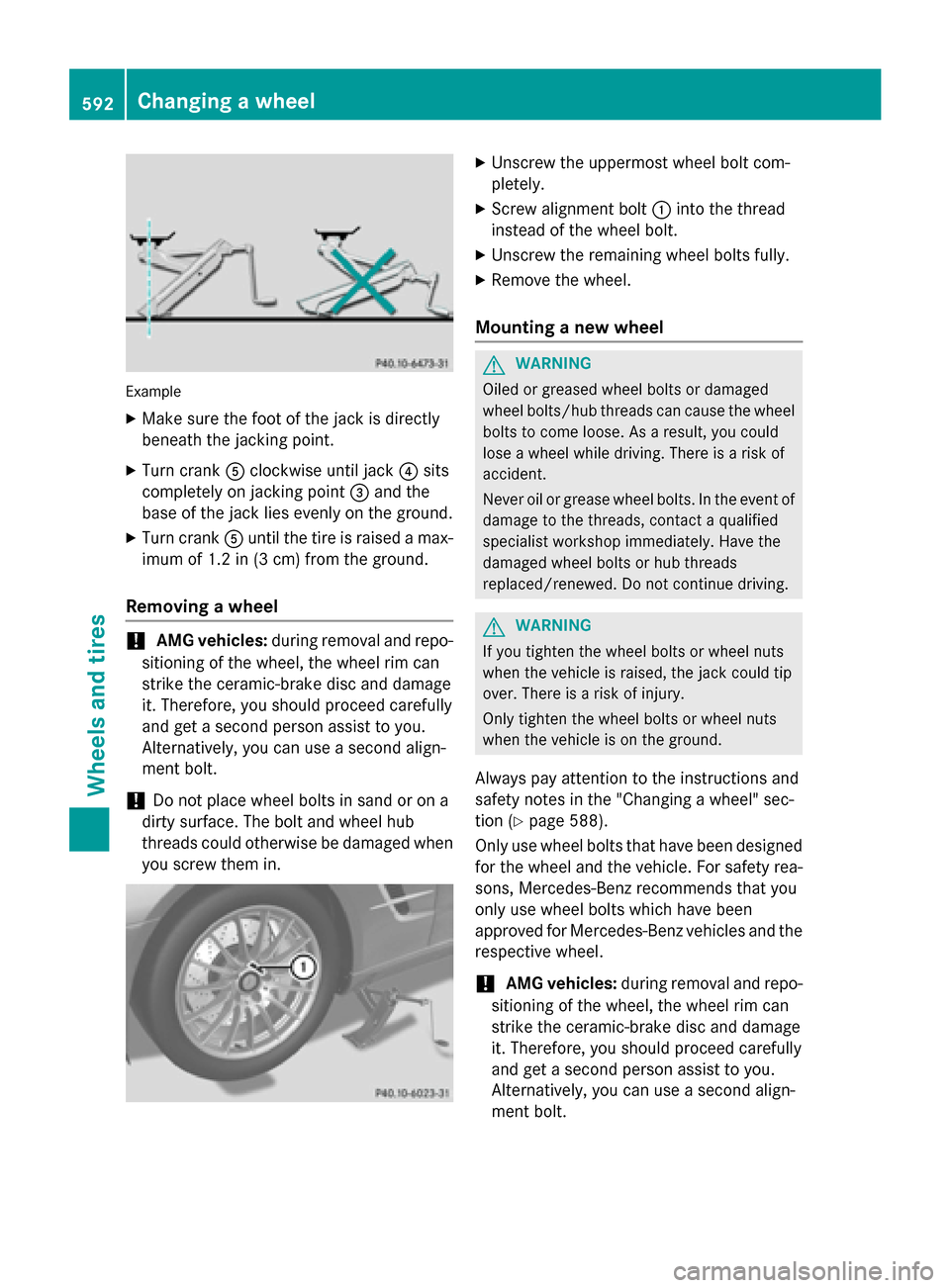
Example
X Make sure the foot of the jack is directly
beneath the jacking point.
X Turn crank 0083clockwise until jack 0085sits
completely on jacking point 0087and the
base of the jack lies evenly on the ground.
X Turn crank 0083until the tire is raised a max-
imum of 1.2 in (3 cm) from the ground.
Removing a wheel !
AMG vehicles:
during removal and repo-
sitioning of the wheel, the wheel rim can
strike the ceramic-brake disc and damage
it. Therefore, you should proceed carefully
and get a second person assist to you.
Alternatively, you can use a second align-
ment bolt.
! Do not place wheel bolts in sand or on a
dirty surface. The bolt and wheel hub
threads could otherwise be damaged when you screw them in. X
Unscrew the uppermost wheel bolt com-
pletely.
X Screw alignment bolt 0043into the thread
instead of the wheel bolt.
X Unscrew the remaining wheel bolts fully.
X Remove the wheel.
Mounting a new wheel G
WARNING
Oiled or greased wheel bolts or damaged
wheel bolts/hub threads can cause the wheel bolts to come loose. As a result, you could
lose a wheel while driving. There is a risk of
accident.
Never oil or grease wheel bolts. In the event of damage to the threads, contact a qualified
specialist workshop immediately. Have the
damaged wheel bolts or hub threads
replaced/renewed. Do not continue driving. G
WARNING
If you tighten the wheel bolts or wheel nuts
when the vehicle is raised, the jack could tip
over. There is a risk of injury.
Only tighten the wheel bolts or wheel nuts
when the vehicle is on the ground.
Always pay attention to the instructions and
safety notes in the "Changing a wheel" sec-
tion (Y page 588).
Only use wheel bolts that have been designed for the wheel and the vehicle. For safety rea-
sons, Mercedes-Benz recommends that you
only use wheel bolts which have been
approved for Mercedes-Benz vehicles and the
respective wheel.
! AMG vehicles:
during removal and repo-
sitioning of the wheel, the wheel rim can
strike the ceramic-brake disc and damage
it. Therefore, you should proceed carefully
and get a second person assist to you.
Alternatively, you can use a second align-
ment bolt. 592
Changing a wheelWheels and tires
Page 595 of 610
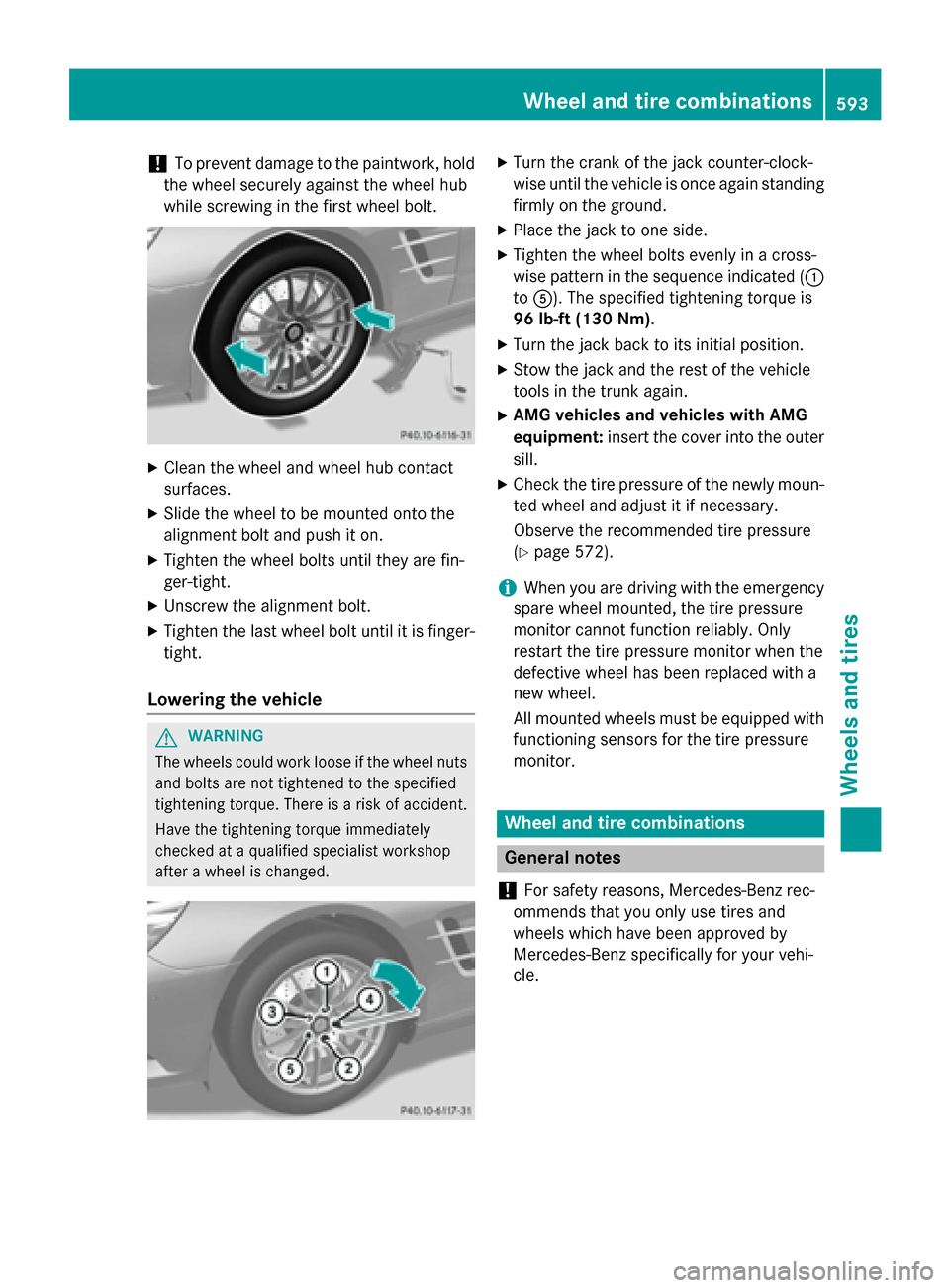
!
To prevent damage to the paintwork, hold
the wheel securely against the wheel hub
while screwing in the first wheel bolt. X
Clean the wheel and wheel hub contact
surfaces.
X Slide the wheel to be mounted onto the
alignment bolt and push it on.
X Tighten the wheel bolts until they are fin-
ger-tight.
X Unscrew the alignment bolt.
X Tighten the last wheel bolt until it is finger-
tight.
Lowering the vehicle G
WARNING
The wheels could work loose if the wheel nuts and bolts are not tightened to the specified
tightening torque. There is a risk of accident.
Have the tightening torque immediately
checked at a qualified specialist workshop
after a wheel is changed. X
Turn the crank of the jack counter-clock-
wise until the vehicle is once again standing
firmly on the ground.
X Place the jack to one side.
X Tighten the wheel bolts evenly in a cross-
wise pattern in the sequence indicated ( 0043
to 0083). The specified tightening torque is
96 lb-ft (130 Nm).
X Turn the jack back to its initial position.
X Stow the jack and the rest of the vehicle
tools in the trunk again.
X AMG vehicles and vehicles with AMG
equipment: insert the cover into the outer
sill.
X Check the tire pressure of the newly moun-
ted wheel and adjust it if necessary.
Observe the recommended tire pressure
(Y page 572).
i When you are driving with the emergency
spare wheel mounted, the tire pressure
monitor cannot function reliably. Only
restart the tire pressure monitor when the
defective wheel has been replaced with a
new wheel.
All mounted wheels must be equipped with
functioning sensors for the tire pressure
monitor. Wheel and tire combinations
General notes
! For safety reasons, Mercedes-Benz rec-
ommends that you only use tires and
wheels which have been approved by
Mercedes-Benz specifically for your vehi-
cle. Wheel and tire combinations
593Wheels and tires Z
Page 596 of 610
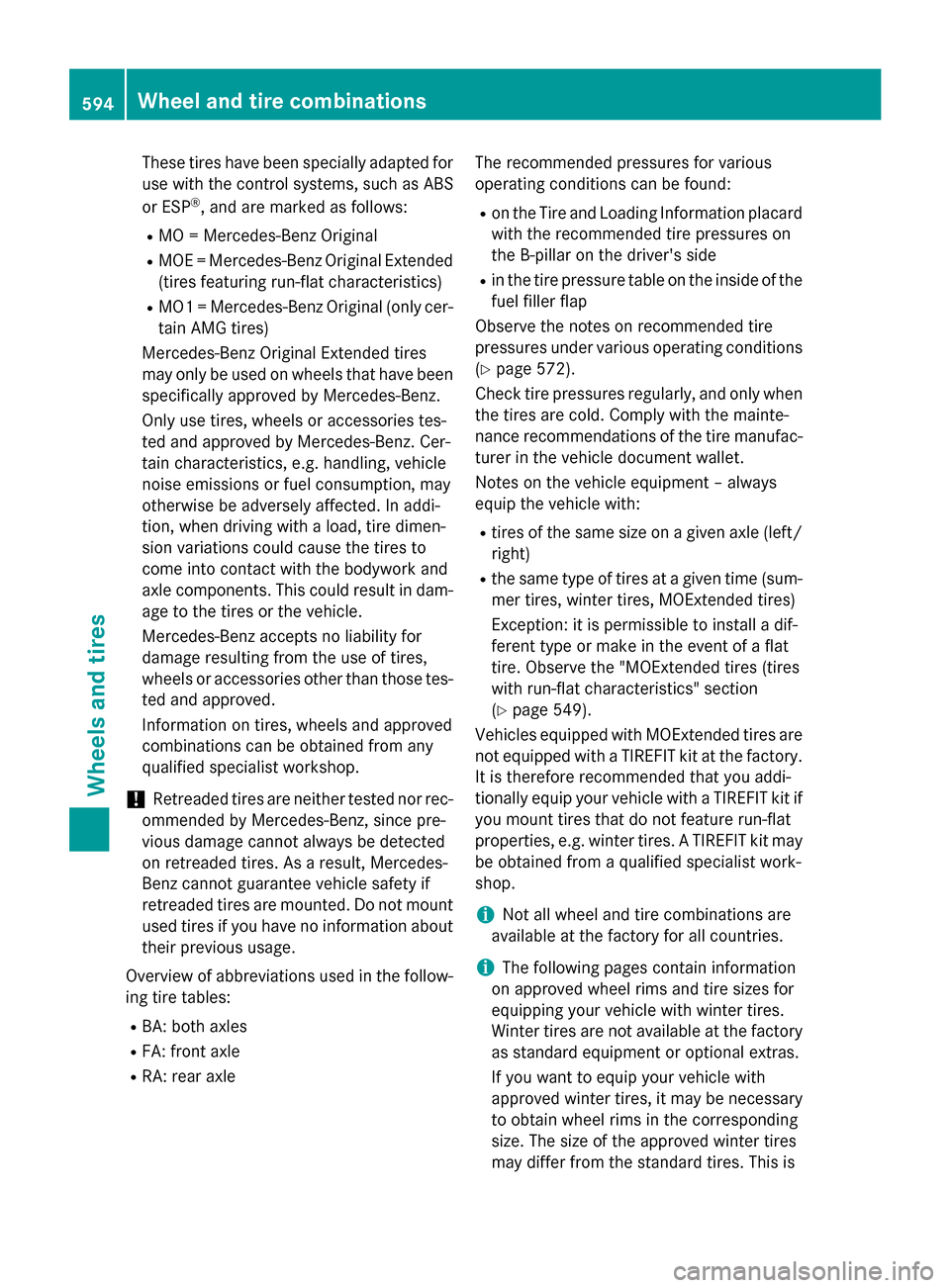
These tires have been specially adapted for
use with the control systems, such as ABS
or ESP ®
, and are marked as follows:
R MO = Mercedes-Benz Original
R MOE = Mercedes-Benz Original Extended
(tires featuring run-flat characteristics)
R MO1 = Mercedes-Benz Original (only cer-
tain AMG tires)
Mercedes-Benz Original Extended tires
may only be used on wheels that have been
specifically approved by Mercedes-Benz.
Only use tires, wheels or accessories tes-
ted and approved by Mercedes-Benz. Cer-
tain characteristics, e.g. handling, vehicle
noise emissions or fuel consumption, may
otherwise be adversely affected. In addi-
tion, when driving with a load, tire dimen-
sion variations could cause the tires to
come into contact with the bodywork and
axle components. This could result in dam- age to the tires or the vehicle.
Mercedes-Benz accepts no liability for
damage resulting from the use of tires,
wheels or accessories other than those tes-
ted and approved.
Information on tires, wheels and approved
combinations can be obtained from any
qualified specialist workshop.
! Retreaded tires are neither tested nor rec-
ommended by Mercedes-Benz, since pre-
vious damage cannot always be detected
on retreaded tires. As a result, Mercedes-
Benz cannot guarantee vehicle safety if
retreaded tires are mounted. Do not mount used tires if you have no information about
their previous usage.
Overview of abbreviations used in the follow-
ing tire tables:
R BA: both axles
R FA: front axle
R RA: rear axle The recommended pressures for various
operating conditions can be found:
R on the Tire and Loading Information placard
with the recommended tire pressures on
the B-pillar on the driver's side
R in the tire pressure table on the inside of the
fuel filler flap
Observe the notes on recommended tire
pressures under various operating conditions (Y page 572).
Check tire pressures regularly, and only when the tires are cold. Comply with the mainte-
nance recommendations of the tire manufac-
turer in the vehicle document wallet.
Notes on the vehicle equipment – always
equip the vehicle with:
R tires of the same size on a given axle (left/
right)
R the same type of tires at a given time (sum-
mer tires, winter tires, MOExtended tires)
Exception: it is permissible to install a dif-
ferent type or make in the event of a flat
tire. Observe the "MOExtended tires (tires
with run-flat characteristics" section
(Y page 549).
Vehicles equipped with MOExtended tires are
not equipped with a TIREFIT kit at the factory. It is therefore recommended that you addi-
tionally equip your vehicle with a TIREFIT kit if
you mount tires that do not feature run-flat
properties, e.g. winter tires. A TIREFIT kit may
be obtained from a qualified specialist work-
shop.
i Not all wheel and tire combinations are
available at the factory for all countries.
i The following pages contain information
on approved wheel rims and tire sizes for
equipping your vehicle with winter tires.
Winter tires are not available at the factory as standard equipment or optional extras.
If you want to equip your vehicle with
approved winter tires, it may be necessary
to obtain wheel rims in the corresponding
size. The size of the approved winter tires
may differ from the standard tires. This is 594
Wheel and tire combinationsWheels and tires
Page 597 of 610
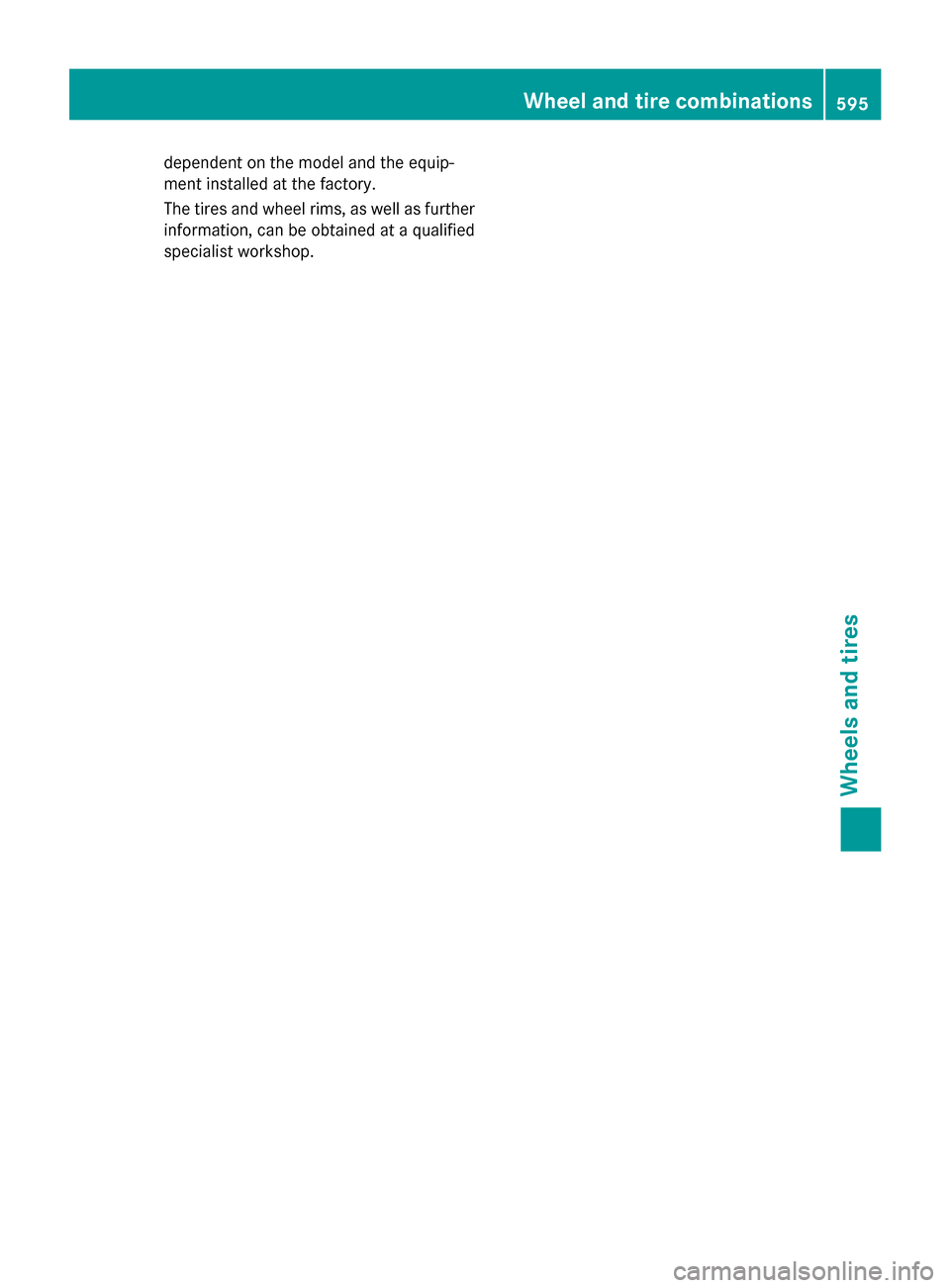
dependent on the model and the equip-
ment installed at the factory.
The tires and wheel rims, as well as further
information, can be obtained at a qualified
specialist workshop. Wheel and tire combinations
595Wheels and tires Z
Page 598 of 610
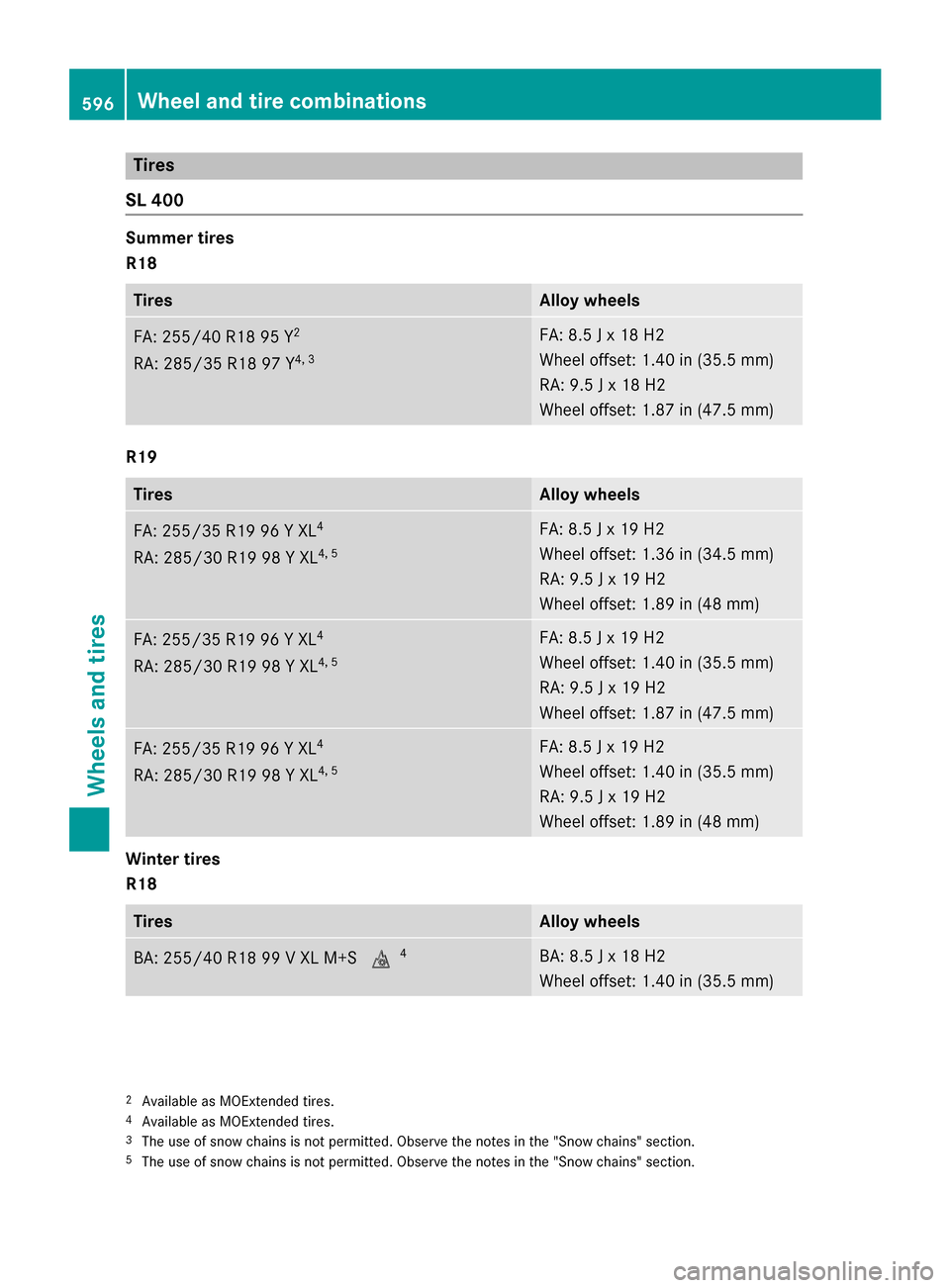
Tires
SL 400 Summer tires
R18
Tires Alloy wheels
FA: 255/4
0 R18 95 Y 2
RA : 285/35 R18 97 Y 4, 3 FA: 8.5 J x 18 H2
Wheel offset: 1.40 in (35.5 mm)
RA: 9.5 J x 18 H2
Wheel offset: 1.87 in (47.5 mm)
R19
Tires Alloy wheels
FA: 255/35 R19 96 Y XL
4
RA: 285/30 R19 98 Y XL 4, 5 FA: 8.5 J x 19 H2
Wheel offset: 1.36 in (34.5 mm)
RA: 9.5 J x 19 H2
Wheel offset: 1.89 in (48 mm)
FA: 255/35 R19 96 Y XL
4
RA: 285/30 R19 98 Y XL 4, 5 FA: 8.5 J x 19 H2
Wheel offset: 1.40 in (35.5 mm)
RA: 9.5 J x 19 H2
Wheel offset: 1.87 in (47.5 mm)
FA: 255/35 R19 96 Y XL
4
RA: 285/30 R19 98 Y XL 4, 5 FA: 8.5 J x 19 H2
Wheel offset: 1.40 in (35.5 mm)
RA: 9.5 J x 19 H2
Wheel offset: 1.89 in (48 mm)
Winter tires
R18
Tires Alloy wheels
BA: 255/40 R18 99 V XL M+S
004D4 BA: 8.5 J x 18 H2
Wheel offset: 1.40 in (35.5 mm)
2
Available as MOExtended tires.
4 Available as MOExtended tires.
3 The use of snow chains is not permitted. Observe the notes in the "Snow chains" section.
5 The use of snow chains is not permitted. Observe the notes in the "Snow chains" section. 596
Wheel and tire combinationsWheels and tires
Page 599 of 610
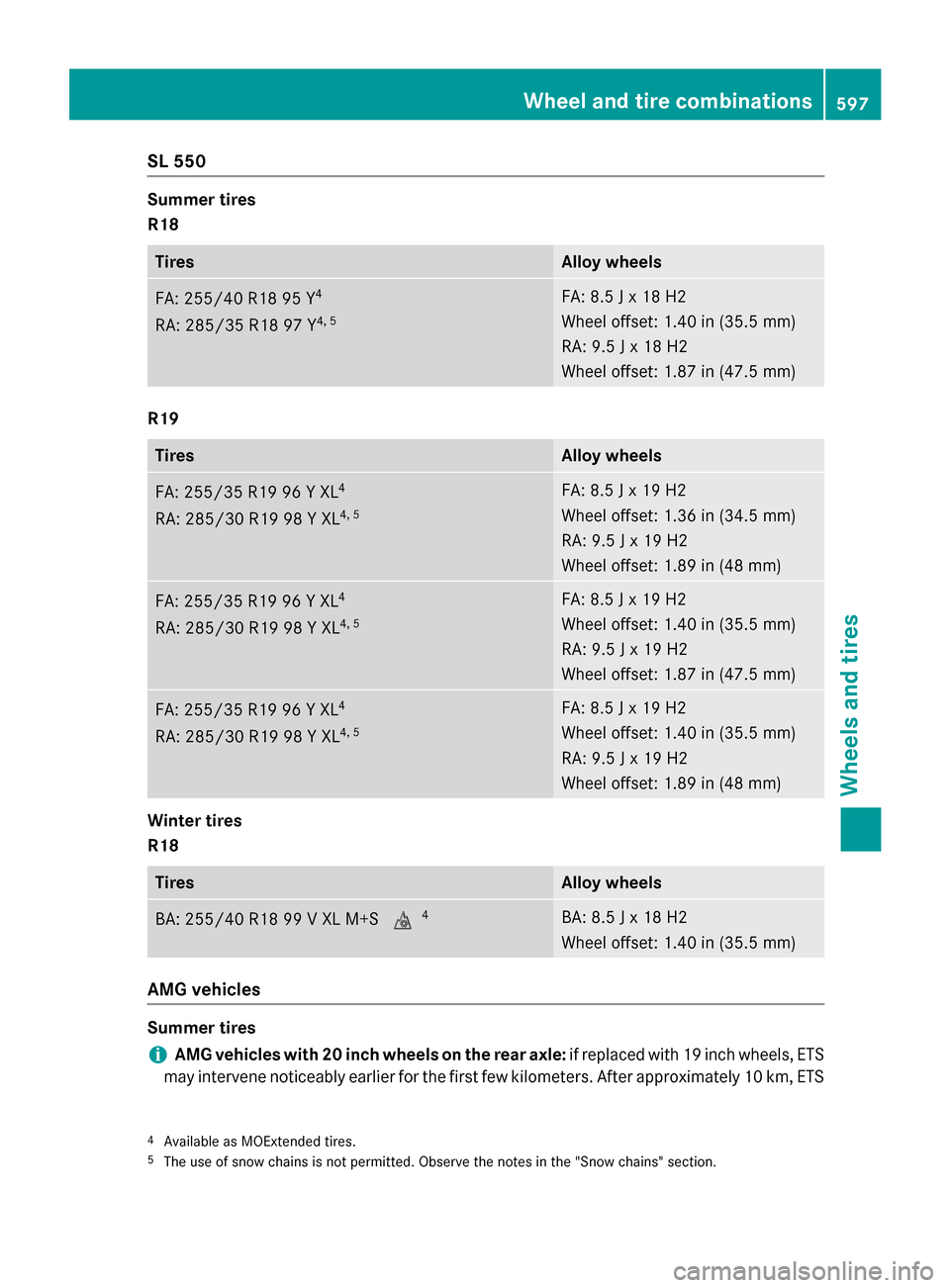
SL 550
Summer tires
R18
Tires Alloy wheels
FA: 255/40 R18 95 Y
4
RA: 285/35 R18 97 Y 4, 5 FA: 8.5 J x 18 H2
Wheel offset: 1.40 in (35.5 mm)
RA: 9.5 J x 18 H2
Wheel offset: 1.87 in (47.5 mm)
R19
Tires Alloy wheels
FA: 255/35 R19 96 Y XL
4
RA: 285/30 R19 98 Y XL 4, 5 FA: 8.5 J x 19 H2
Wheel offset: 1.36 in (34.5 mm)
RA: 9.5 J x 19 H2
Wheel offset: 1.89 in (48 mm)
FA: 255/35 R19 96 Y XL
4
RA: 285/30 R19 98 Y XL 4, 5 FA: 8.5 J x 19 H2
Wheel offset: 1.40 in (35.5 mm)
RA: 9.5 J x 19 H2
Wheel offset: 1.87 in (47.5 mm)
FA: 255/35 R19 96 Y XL
4
RA: 285/30 R19 98 Y XL 4, 5 FA: 8.5 J x 19 H2
Wheel offset: 1.40 in (35.5 mm)
RA: 9.5 J x 19 H2
Wheel offset: 1.89 in (48 mm)
Winter tires
R18
Tires Alloy wheels
BA: 255/40 R18 99 V XL M+S
004D4 BA: 8.5 J x 18 H2
Wheel offset: 1.40 in (35.5 mm)
AMG vehicles
Summer tires
i AMG vehicles with 20 inch wheels on the rear axle:
if replaced with 19 inch wheels, ETS
may intervene noticeably earlier for the first few kilometers. After approximately 10 km, ETS
4 Available as MOExtended tires.
5 The use of snow chains is not permitted. Observe the notes in the "Snow chains" section. Wheel and tire combinations
597Wheels and tires Z
Page 600 of 610
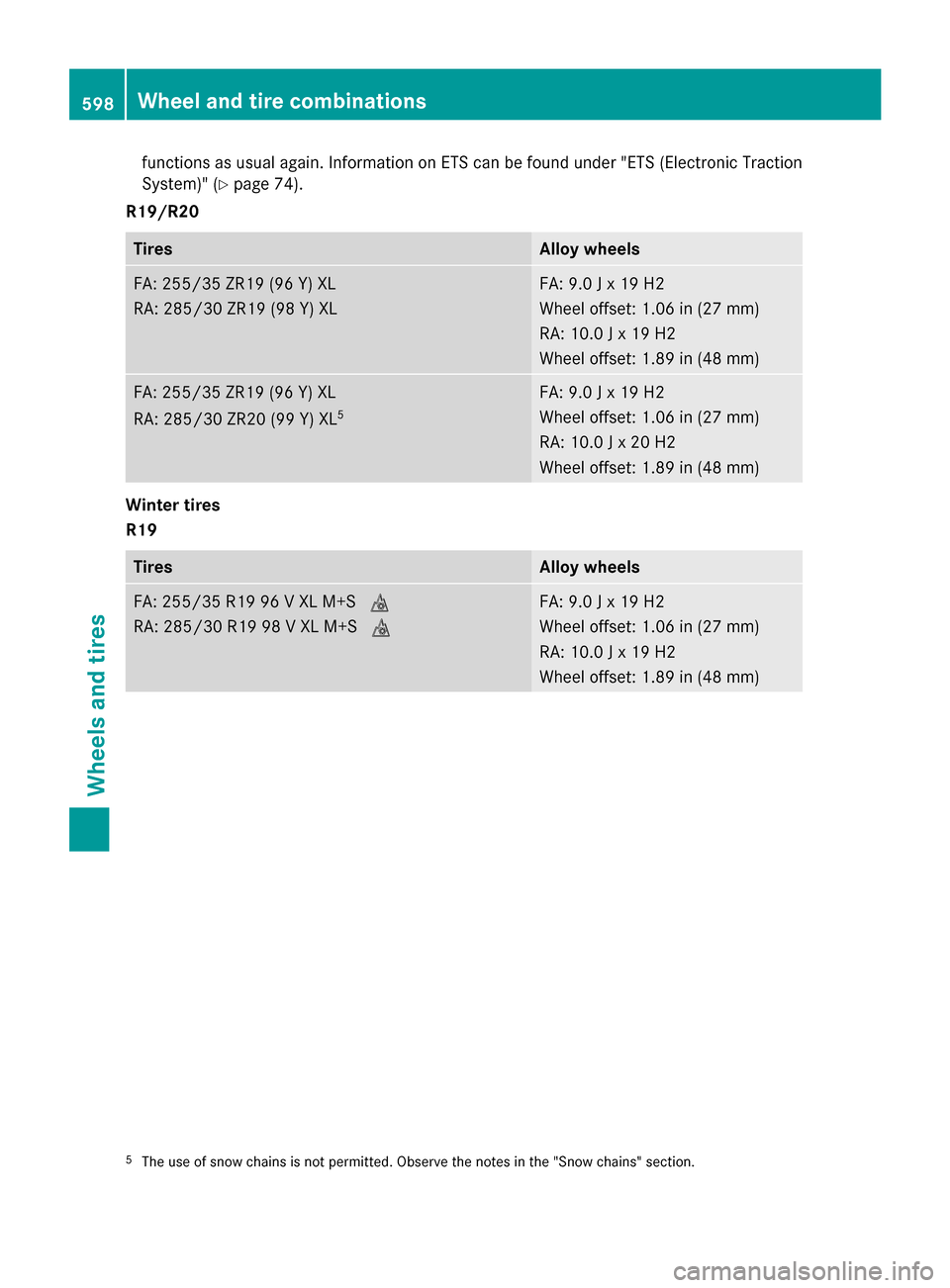
functions as usual again. Information on ETS can be found under "ETS (Electronic Traction
System)" (Y page 74).
R19/R20 Tires Alloy wheels
FA: 255/35 ZR19 (96 Y) XL
RA: 285/30 ZR19 (98 Y) XL FA: 9.0 J x 19 H2
Wheel offset: 1.06 in (27 mm)
RA: 10.0 J x 19 H2
Wheel offset: 1.89 in (48 mm)
FA: 255/35 ZR19 (96 Y) XL
RA: 285/30 ZR20 (99 Y) XL
5 FA: 9.0 J x 19 H2
Wheel offset: 1.06 in (27 mm)
RA: 10.0 J x 20 H2
Wheel offset: 1.89 in (48 mm)
Winter tires
R19 Tires Alloy wheels
FA: 255/35 R19 96 V XL M+S
004D
RA: 285/30 R19 98 V XL M+S 004D FA: 9.0 J x 19 H2
Wheel offset: 1.06 in (27 mm)
RA: 10.0 J x 19 H2
Wheel offset: 1.89 in (48 mm)
5
The use of snow chains is not permitted. Observe the notes in the "Snow chains" section. 598
Wheel and tire combinationsWheels and tires